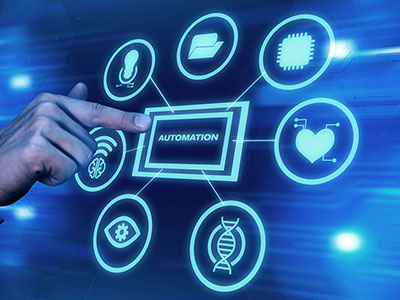
The Rise of AI and Intelligent Chatbots in Government Services
Table of Contents
- 1. What Operational Benefits have Government Agencies Realized through AI and Chatbot implementation?
- 2. Chatbots for Easy Access and Effective Public Services
- 3. Overcoming Challenges in Adopting AI in State and Local Governments
- 4. Public Sector AI Adoption: Explore Critical Considerations to Address
- 5. Summing Up!
Governments need to look to and learn from private sector companies that are leading the way in AI implementation. Many government agencies have started experimenting with AI and Chatbots through small pilot projects.
Talk to Our Automation Expert!
+91 855-975-9735
Want to experience Intelligent Automation in Action or Need help Building the Right Automation Plan?
According to the 2023 Government Chatbot Adoption Report by Accenture, citizens are leveraging chatbots to access a variety of government services, including:
- Tax inquiries (30% of interactions)
- Passport applications (20% of interactions)
- Social welfare support (15% of interactions)
- Permit and license renewals (10% of interactions)

The widespread adoption of these conversational AI chatbots has led to substantial operational enhancements for government agencies.
What Operational Benefits have Government Agencies Realized through AI and Chatbot implementation?

When implemented effectively, AI can generate significant benefits for public sector organizations in three crucial ways.
Smarter Policymaking
AI-powered data analytics and predictive modeling empower governments to make more informed, evidence-based decisions when developing policies and programs. This data-driven approach leads to better-targeted, more impactful initiatives that address the true needs of citizens.
Reimagined Service Delivery
Conversational AI, process automation, and personalized citizen experiences can revolutionize how governments interact with and serve their constituents. By leveraging these AI-enabled capabilities, public agencies can deliver more responsive, accessible, and tailored services that enhance the overall citizen experience.
Operational Optimization
AI can optimize internal workflows, enhance resource allocation, and reduce costs across various government functions and agencies. This operational efficiency frees up resources that can be reinvested to further improve public services and meet the evolving needs of communities.
Chatbots for Easy Access and Effective Public Services
Government chatbots entail several long-term benefits for the government services that use them. In a nutshell, they aid Federal Governments sculpt a better image in the eyes of their citizens.
- Improved Access to Information and Services: Chatbots can provide quick and accurate responses to popular questions, allowing citizens to easily locate the information or services they require.
- Cost Savings: Chatbots can assist lower the costs associated with citizen service by responding quickly to simple questions and freeing up citizen service workers to focus on more complicated issues.
- Elevated Citizen Satisfaction: By delivering timely and accurate responses, chatbots can enhance the overall satisfaction of citizens interacting with government services.
- Streamlined Operations: The automation of processes that would traditionally require manual effort can help government agencies streamline their operations and improve efficiency.
Overcoming Challenges in Adopting AI in State and Local Governments
Implementing AI in state and local government agencies faces several key challenges. One major obstacle is resistance to change, with many officials and employees apprehensive about AI due to fears of job displacement or concerns about privacy and security. Addressing these concerns through clear communication and education about the benefits and safeguards of AI is crucial to overcoming resistance.
Another significant challenge is the need for extensive data management. AI relies on large volumes of quality data, but government agencies often lack well-organized, accessible data repositories, leading to data silos and inconsistencies. Investing in data infrastructure and establishing data governance frameworks, as well as cross-agency collaboration, can help address this issue.
By proactively addressing these challenges, state and local governments can unlock the transformative potential of AI to enhance public services, optimize operations, and better serve their communities.
Public Sector AI Adoption: Explore Critical Considerations to Address
Implementing AI in the public sector raises several critical considerations and sensitivities.
The primary concern is the transparency and accountability of AI systems used by government organizations.

Some of the other considerations include:
- Privacy and Data Security
- Impact on Employment Structures
- Equity and Fairness
- Limited Resources to Invest
Summing Up!
Public servants have the important job of making sure everyone in the community has access to essential services like healthcare, education, and basic needs. But they often face challenges like heavy workloads and outdated systems that make it hard to do their jobs well.
Adopting artificial intelligence (AI) can help public sector agencies solve these problems. AI can quickly process a lot of information, automate repetitive tasks, and provide assistance 24/7. By using AI-powered solutions, government agencies can empower their public servants to deliver better, more accessible services to the community. This technology can streamline workflows, improve decision-making, and expand the reach of vital public programs.
Seeking a comprehensive government automation solution?
AIRPA's integrated toolkit empowers government organizations to streamline workflows, optimize operations, and deliver superior citizen experiences through the power of low-code automation.
Partner with us to drive operational excellence, foster greater community engagement, and fulfill your agency's mission to better serve the public.
Empower Your Agency to Deliver Exceptional Public Services!
Popular Tags:
Related Articles

How Automation and AI are Reshaping the Fintech Landscape
Is AI the driving force behind fintech's rapid evolution?





